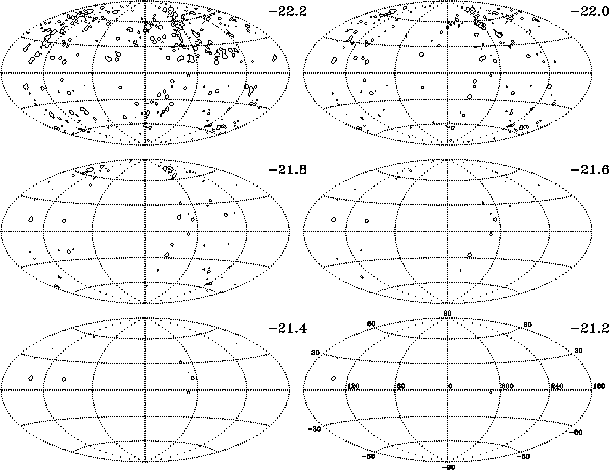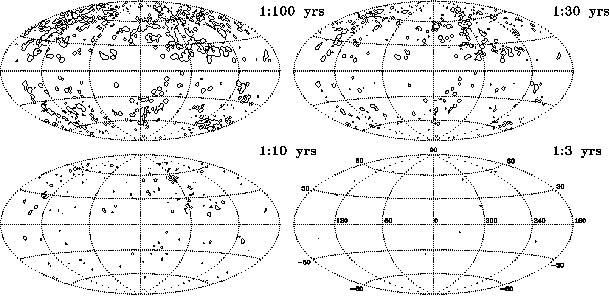Next: Gravitational Waves from Coalescing Up: A Gravitational Wave Map Previous: A Gravitational Wave Map
![]()
![]()
![]()
![]()
![]()
Next: Gravitational
Waves from Coalescing Up: A
Gravitational Wave Map Previous: A
Gravitational Wave Map
The observed supernova frequencies of different types (SN Ia, Ib, II) in different types of galaxies (E-...-S-...-Ir) (see van den Bergh and Tammann, 1991[200]) immediately provide us with the SN frequency distribution in space. We can investigate projection of this distribution onto the celestial sphere in two ways: in terms of lines of constant SN frequencies per one square degree for all galaxies from the sample (Figure 36), and in terms of constant GW amplitudes at a given SN frequency per square degree (Figure 44).

Figure 44: Distribution of GW amplitudes from SN events over the
sky. Inside regions encircled by the lines the total SN event rate >1/30 yr![]() deg
deg![]() at a given level of
at a given level of ![]() (Lipunov et al., 1995a).
(Lipunov et al., 1995a).
Inside regions encircled by the lines of constant SN frequency in Figure 45, the total SN frequency exceeds 1 per 3, 10, 30 and 100 year per square degree, respectively. This figure represents the cross-sections of the projected mass density per square degree by mass.

Figure 45: The sky distribution of the total supernova frequency
from nearby galaxies in terms of lines of equal frequencies per square
degree. The total SN frequency exceeds 1 per 3, 10, 30 and 100 year per
square degree inside regions encircled by the lines (Lipunov et al.,
1995a).
Inside regions encircled by the lines of constant ![]() (Figure 44), the total SN event rate
(Figure 44), the total SN event rate ![]() at a given level of
at a given level of ![]() . In other words, the cross-sections of nearby galaxy space distribution
by distance are given by this figure.
. In other words, the cross-sections of nearby galaxy space distribution
by distance are given by this figure.
We assume after Thorne (1988)[191]
the characteristic strain metric amplitude ![]() to be:
to be:

where ![]() is a
distance to the source,
is a
distance to the source, ![]() is the total energy radiated as GW; a conservative estimate of GW energy
during SN explosion
is the total energy radiated as GW; a conservative estimate of GW energy
during SN explosion ![]() 0.1
percent of the expected neutrino luminosity is used.
The characteristic frequency of the GW burst is assumed
to be 1 kHz. We must note that GW bursts produced by supernova explosions
have been poorly understood so far, so only relative figures of
0.1
percent of the expected neutrino luminosity is used.
The characteristic frequency of the GW burst is assumed
to be 1 kHz. We must note that GW bursts produced by supernova explosions
have been poorly understood so far, so only relative figures of ![]() may have meaning.
may have meaning.
In Figure 46 the SN rates of different
types integrated over the whole sky are plotted as a function of a given
detector sensitivity in terms of the strain metric amplitude h.
Clearly seen are contributions from the closest groups of galaxies and
the Virgo cluster (assuming a Hubble constant of 75 km s![]() ).
At better sensitivities (
).
At better sensitivities (![]() ) a power
law with a slope of -3 is seen,
) a power
law with a slope of -3 is seen, ![]() , which reflects the almost isotropical distribution of matter beyond
, which reflects the almost isotropical distribution of matter beyond ![]() 7 Mpc.
The total rate of SN events over the sky for nearby galaxies is about 40
per year.
7 Mpc.
The total rate of SN events over the sky for nearby galaxies is about 40
per year.
Figure 46: SNe rates of different types integrated over the whole
sky as a function of a given detector sensitivity in terms of strain metric
amplitude h. Contributions from some close
groups of galaxies are indicated (Lipunov et al., 1995a).